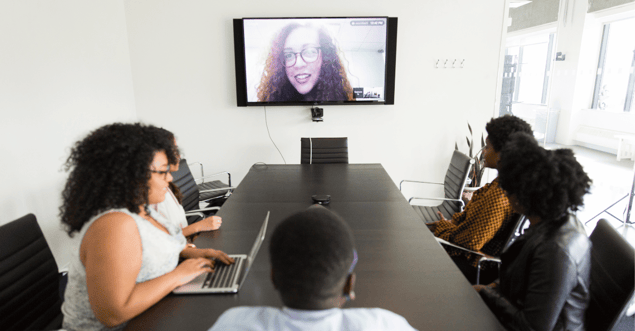Remote work, which was just once a necessity during the pandemic, will continue to thrive throughout 2023. Today, flexibility is a key demand for candidates on the job market, and the traditional 9-5 workday is quickly becoming a thing of the past according to an article by Harvard Business Review. But while flexible work arrangements offer employees more autonomy, they can come with their own set of challenges. In this article, we'll walk you through four challenges in our new world of work and how to tackle them, one by one.

Challenge 1: Lack of relevant skills
A fast-changing society and unpredictable market demands means that we continuously need to keep up with the necessary skills needed in the world of work. According to The World Economic Forum, over half of all global employees will have to upskill or reskill by 2025 to keep up with the evolution of jobs. Whereas back in the day, companies were able to more easily predict upcoming needs for a certain skill and recruit accordingly.
The world is moving towards a skills-based economy where businesses struggle to attract and keep the employees best suited for the job. How do we best future-proof our organizations and essentially benefit from a fast-changing labor market?
Solution: Upskilling and reskilling
Skill development is becoming crucial in order to tackle unpredictability and new advancements in our digital society. Therefore, companies must prioritize upskilling and reskilling to future-proof their workforce. Modern companies can no longer see new recruitment as the only solution but must also develop their existing employees with new career and skill opportunities. Make sure to initiate training programs and develop individual development plans for each employee - it doesn’t not only show that you’re serious about your employees growth and advancement. Taking an internal approach makes you more resourceful in terms of the potential that already lies within your organization.
Challenge 2: A hybrid workplace
Many companies are propelling toward a hybrid solution, and the way towards redesigning work arrangements will significantly depend on how your company is currently operating. In our recruitment trends report 2023, a highlighted report conducted by CNBC showed that 64% of employees never want to return to the office full-time. They said they would rather quit and look for a new employer that would allow them to work remotely. How do we manage a hybrid arrangement while fostering a productive and human-centric organization?
Solution: Create an hybrid model
In order to maintain a sustainable hybrid model, we have to start with cultivating proper guidelines to ensure that employees know how to navigate in their specific role and know what’s expected of them in a hybrid environment. Although it's a big challenge with many individual solutions, here are a few suggestion to get you started:
- Enable better share-filing; documents should be sharable to facilitate asynchronous communication.
- Implement a day-to-day communication platform, i.e. a virtual office where everyone can "meet" regardless of their geographical location. Some platforms on the market include Teemyco (think The Sims but the professional version) or slack that enables you to effectively communicate across teams.
- Create shared experiences. Cultivating a work culture doesn’t necessarily happen in between four walls. Therefore, implementing regular check-in’s or more spontaneous virtual gatherings like organizing an after-work is vital to strengthen that sense of connectedness.
- Make sure to create an inclusive environment when facilitating virtual meetings, one major component here is to make sure that everyone is calling in from a separate screen to avoid that people in the office are dominating the flow of the conversation.
Challenge 3: Work-life balance
Instead of workers fitting themselves into a job description, the tables have now turned and workers no longer want to compromise their quality of life for a career. Whether that means more quality time for their family, squeezing in a surf session in the morning or just not having to do the daily 2h commute. The pandemic opened up a whole new set of possibilities to get the life puzzle together and create a more meaningful reality for themselves.
Solution: Cultivating a people-first culture
Well-being at work has accelerated to the top of the business agenda during the pandemic and continues to be a high priority for companies in a new world of work. In practice, that means creating safe spaces for hybrid work where quality wins over the amount of hours put in, where working overtime isn’t equivalent to how invested an employee is, and essentially where people's well-being comes before profit.
When speaking about the importance of a healthy work-life-balance, the most powerful action of them all is for you to model the transparent climate you wish to see. It’s not only a powerful statement but a way to encourage employees to feel safe enough to do it themselves. To show that you don’t only value your employees when they're productive, but in all aspects of their professional being. With that said, here are some ideas to help you get started:
- Implement mental health days off
- Don’t encourage work outside of the ordinary business hours
- Create a safe space for regular check-in’s with your team that doesn’t involve a business agenda. Simply starting with a “how are you” (and caring about the answer) is how we eventually create longevity and trust within an organization
Challenge 4: Proximity bias
As employees return to the office, companies embracing hybrid work arrangements face a challenge – proximity bias. This could mean offering the ones working from the office more exciting projects or development opportunities, leaving remote colleagues out of the decision-making and essential discussions, and – leaving them with a feeling of exclusion. Which is also referred to as the “out of sight, out of mind” phenomenon.
Solution: Awareness and action
Knowing how proximity affects your decision-making is key to creating a more fair and inclusive working environment. We can’t eliminate all of our biases, but being aware of them helps us cultivate more objective ways to communicate, reward, collaborate and create a sense of belonging. Standardized methods and reward based on metrics instead will help you to reduce your own bias and provide opportunities for your less visual employees.
The times when we thought ping-pong tables and breakfast on Fridays were enough to impress top talents are gone, rightfully so. Investing in a modern workplace that resonates with candidates and their preferred workplace attributes will not only help you win the war for talent, it’s a critical step if you want to keep up with the evolving workforce and future-proof your organization.
Make sure to download our 2023 Recruitment Trend Report for the in-depth insights and how you as a hiring manager can utilize these to maintain a competitive advantage throughout 2023 and beyond.
Last updated: